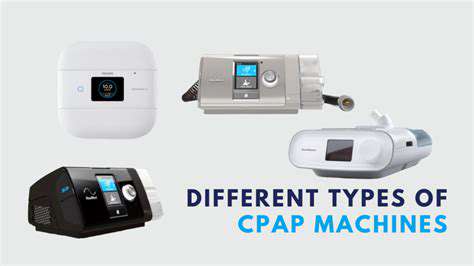Choosing the Right CPAP Device: A Comprehensive Guide
Jan 18, 2025 / zsfcdn103/
Introduction to CPAP Treatment
Understanding CPAP Devices
CPAP (Continuous Positive Airway Pressure) devices are medical equipment used to treat sleep apnea, a condition where a person's breathing stops and starts during sleep.
These devices work by delivering a steady stream of air pressure into the airways, keeping them open and preventing pauses in breathing.
CPAP devices are typically small, portable machines that can be placed on a bedside table or taken on the go.
They are equipped with a hose and mask that deliver the air pressure, and some models come with additional features such as humidifiers and heated hoses.
Types of CPAP Devices
There are several types of CPAP devices available, each with its own unique features and benefits.
Fixed-pressure CPAP devices deliver a constant stream of air pressure, while auto-adjusting CPAP devices adjust the pressure throughout the night based on the user's breathing patterns.
Bilevel CPAP devices deliver two different levels of air pressure, one for inhalation and one for exhalation, which can be more comfortable for some users.
Travel CPAP devices are small, lightweight, and portable, making them ideal for people who need to use their device while traveling.
Some CPAP devices also come with advanced features such as wireless connectivity, data tracking, and mobile apps, which can help users monitor their sleep patterns and adjust their treatment as needed.
Factors to Consider When Choosing a CPAP Device
When choosing a CPAP device, there are several factors to consider, including the type of sleep apnea being treated, the user's comfort level, and their lifestyle.
Users should consider the noise level of the device, as some models can be quite loud, and the size and portability of the device, as some models are more compact than others.
The mask and hose should also be considered, as some users may prefer a full-face mask while others may prefer a nasal mask or nasal pillows.
Additionally, users should consider the cost of the device, as well as any additional features or accessories that may be needed, such as a humidifier or heated hose.
It's also important to consult with a healthcare professional to determine the best type of CPAP device for individual needs and to ensure proper fitting and adjustment of the device.
Types of CPAP Machines

Understanding Different Types of CPAP Machines
CPAP machines come in various types, each designed to cater to specific needs of patients with sleep apnea. The most common type is the standard CPAP, which delivers a continuous flow of air to keep the airways open. People who have obstructive sleep apnea often benefit the most from this type of CPAP machine.
Another option is the Auto CPAP, which automatically adjusts the pressure based on the patient’s needs throughout the night. This device is particularly advantageous for those whose pressure requirements change during sleep. This feature ensures optimal therapy while maintaining comfort.
There are also Bi-Level Positive Airway Pressure (BiPAP) machines, which provide two different pressure levels: one for inhalation and another for exhalation. This dual-pressure system may be more comfortable for patients who struggle with standard CPAP devices. Choosing the right type of machine is paramount for effective treatment.
Factors to Consider When Selecting a CPAP Device
When choosing a CPAP machine, it’s essential to consider your specific needs, as well as any recommendations from healthcare providers. Factors like comfort, noise levels, and portability should influence your decision. For travel enthusiasts, a lightweight and compact machine might be the best option.
Insurance coverage is another critical component, as different devices may come with varying cost implications. It’s advisable to check with your provider regarding which CPAP machines are covered under your health plan. Budget considerations should also factor into the final decision.
Finally, checking out user reviews and experiences can provide additional insights into the effectiveness and comfort levels of specific models. The experiences shared by others can guide you in making a well-informed decision about your CPAP therapy. Remember that each person’s needs are unique, so personalized advice is invaluable.
Key Features to Consider When Choosing a CPAP Device
Understanding Different Types of CPAP Devices
When selecting a CPAP device, it's essential to understand the various types available on the market. The most common types include standard CPAP machines, auto-adjusting CPAP (APAP) devices, and BiPAP machines. Each type has its unique features designed to cater to different needs.
Standard CPAP machines deliver a constant airflow, maintaining an uninterrupted pressure throughout the night. This is suitable for patients who require consistent air pressure to keep their airways open.
Auto-adjusting CPAP devices are designed to automatically adjust the pressure based on the user's breathing patterns. This flexibility allows users to receive the appropriate pressure during different phases of their sleep cycle.
BiPAP machines, or bilevel positive airway pressure devices, provide two distinct pressure levels for inhalation and exhalation. They are often recommended for users who experience higher pressure needs or have conditions that make it difficult to exhale against the air pressure.
Choosing the right type of CPAP device depends on various factors such as prescription, personal comfort, and specific medical conditions. Consulting with a healthcare provider can help ensure you select a device that meets your individual needs.
Comfort and Usability Features to Look For
Comfort is a critical factor in ensuring the successful use of a CPAP device over the long term. Many modern CPAP machines offer features designed to enhance comfort, such as humidifiers, heated tubing, and quiet operation.
A built-in humidifier can help prevent dryness and irritation in the airway, making it more comfortable to use the machine, especially during cold or dry weather. Heated tubing can also contribute to comfort by maintaining optimal temperature and humidity levels in the air delivered.
Noise levels can significantly affect the user's sleep quality. Many contemporary CPAP models are designed to operate quietly, which can help ensure a peaceful night's sleep for both the user and their partner.
Additionally, user-friendly interfaces with clear displays can make a significant difference. Features like easy-to-navigate menus and connectivity options to track usage through smartphone apps can enhance the overall experience.
Ultimately, evaluating comfort features and usability can greatly influence how well users adapt to their CPAP therapy. Taking time to assess these aspects can improve compliance and effectiveness of treatment.
Consulting with a Healthcare Professional

Understanding Your Sleep Needs
Before selecting a CPAP device, it's essential to have a clear understanding of your individual sleep needs. Each person's sleep apnea condition can vary significantly, necessitating a tailored approach to treatment. Factors like the severity of your condition, lifestyle preferences, and additional health issues can influence the type of CPAP machine that may be suitable for you.
Consulting a healthcare professional is vital in addressing these specific needs. A sleep study can determine the appropriate pressure settings and device features required for effective treatment. This personalized assessment can lead to a more successful management of your sleep apnea.
Moreover, your healthcare provider can guide you on how to use the equipment properly and adjust settings as your condition changes over time. A proactive approach will help in optimizing your therapy and ensuring better sleep quality.
Exploring Different CPAP Options
There are various types of CPAP devices available, including standard CPAP machines, auto-adjusting machines, and bi-level positive airway pressure (BiPAP) devices. Understanding the distinctions among these options is crucial. Each type offers different mechanisms for delivering air pressure, catering to varying needs.
For instance, auto CPAP machines can automatically adjust the pressure throughout the night based on your breathing patterns, providing enhanced comfort. In contrast, BiPAP devices may be better suited for users who require different pressures for inhalation and exhalation.
By discussing these options with your healthcare provider, you can make an informed choice that aligns with your specific preferences and medical requirements. This dialogue can also help you consider factors such as noise levels, portability, and ease of use.
Evaluating Comfort and Usability
Comfort is a key component when selecting a CPAP device. Many patients report discomfort from masks, noise from machines, and challenges with machine settings. It's essential to find a CPAP device that caters to your comfort needs to ensure adherence to treatment.
Different masks come in various styles, sizes, and materials, impacting how they fit and feel on your face. A well-fitting mask is crucial for maximizing treatment effectiveness and minimizing airflow leaks, which can disrupt sleep.
Additionally, usability features such as easy-to-read displays, remote monitoring options, and user-friendly controls can significantly enhance your overall experience. Ensuring that you feel confident in using your device will contribute immensely to consistent and effective therapy.
Assessing Cost and Insurance Coverage
Cost is another critical factor when choosing the right CPAP device. Prices can vary widely based on the technology and features included in the machine. It's important to assess what fits your budget while still meeting your therapeutic needs.
Insurance coverage can also play a significant role in the decision-making process. Many insurance plans offer partial or total coverage for CPAP devices and supplies, but the extent of coverage can differ. Therefore, discussing your options with your insurance provider can clarify what products will be financially accessible to you.